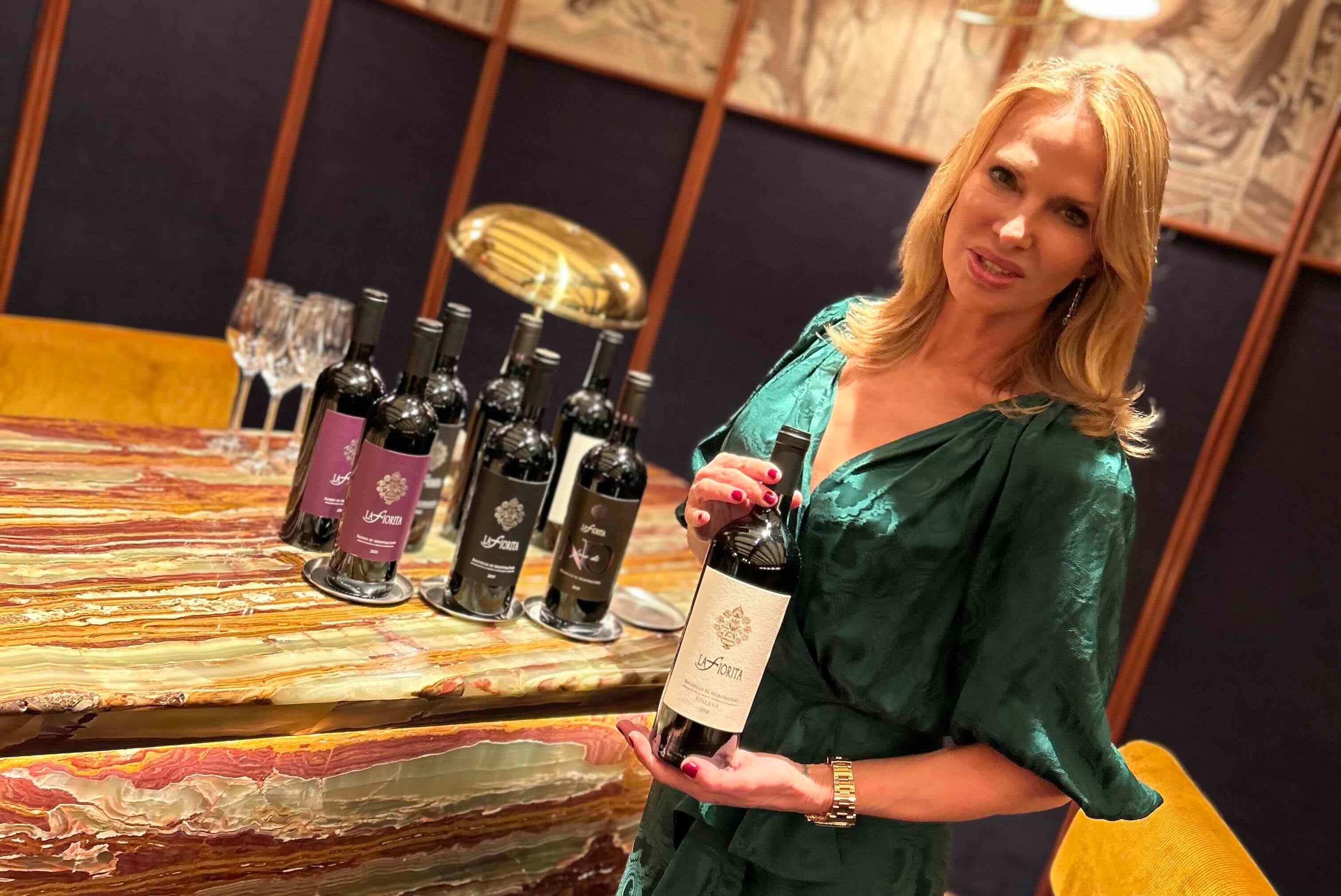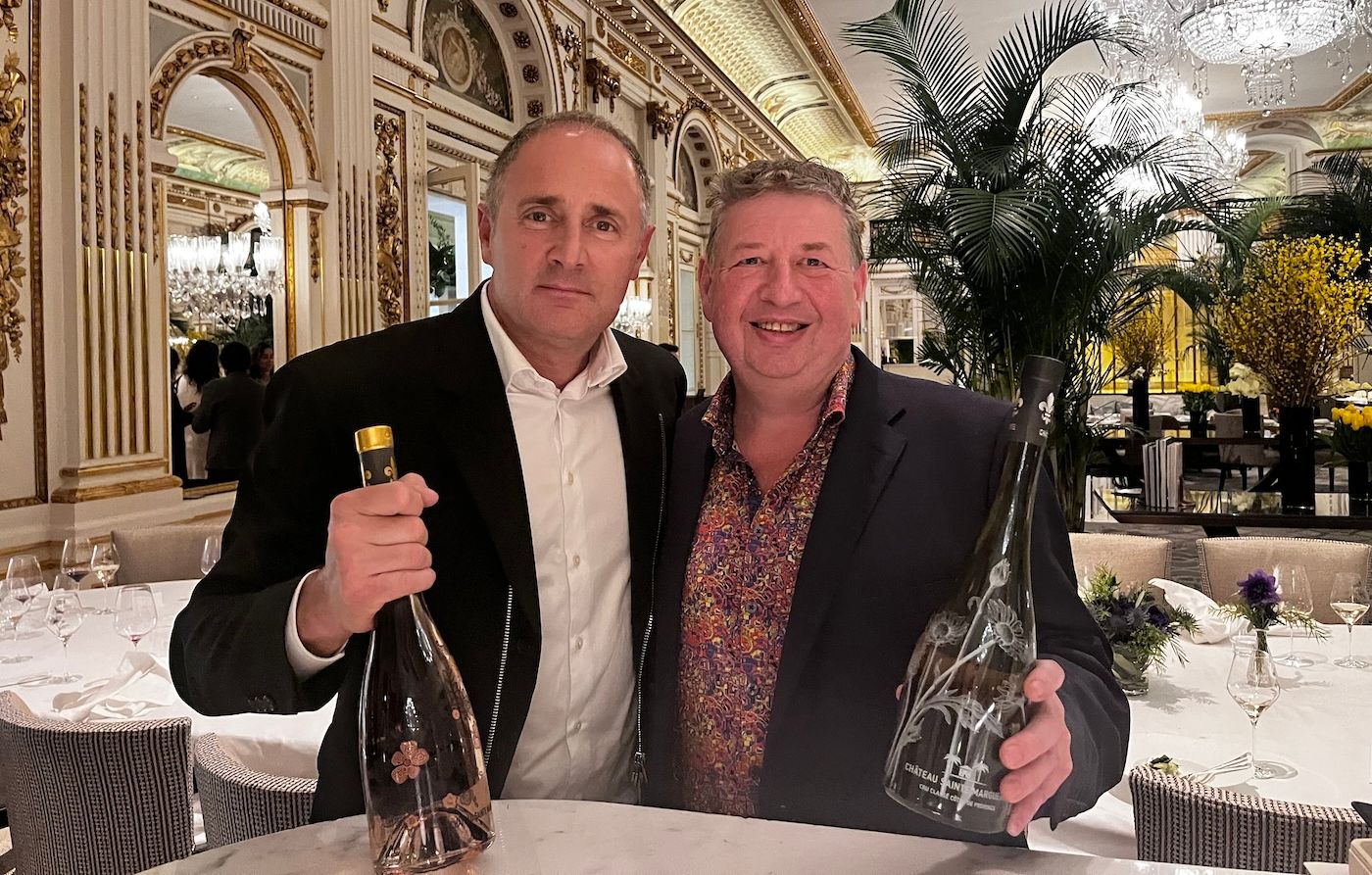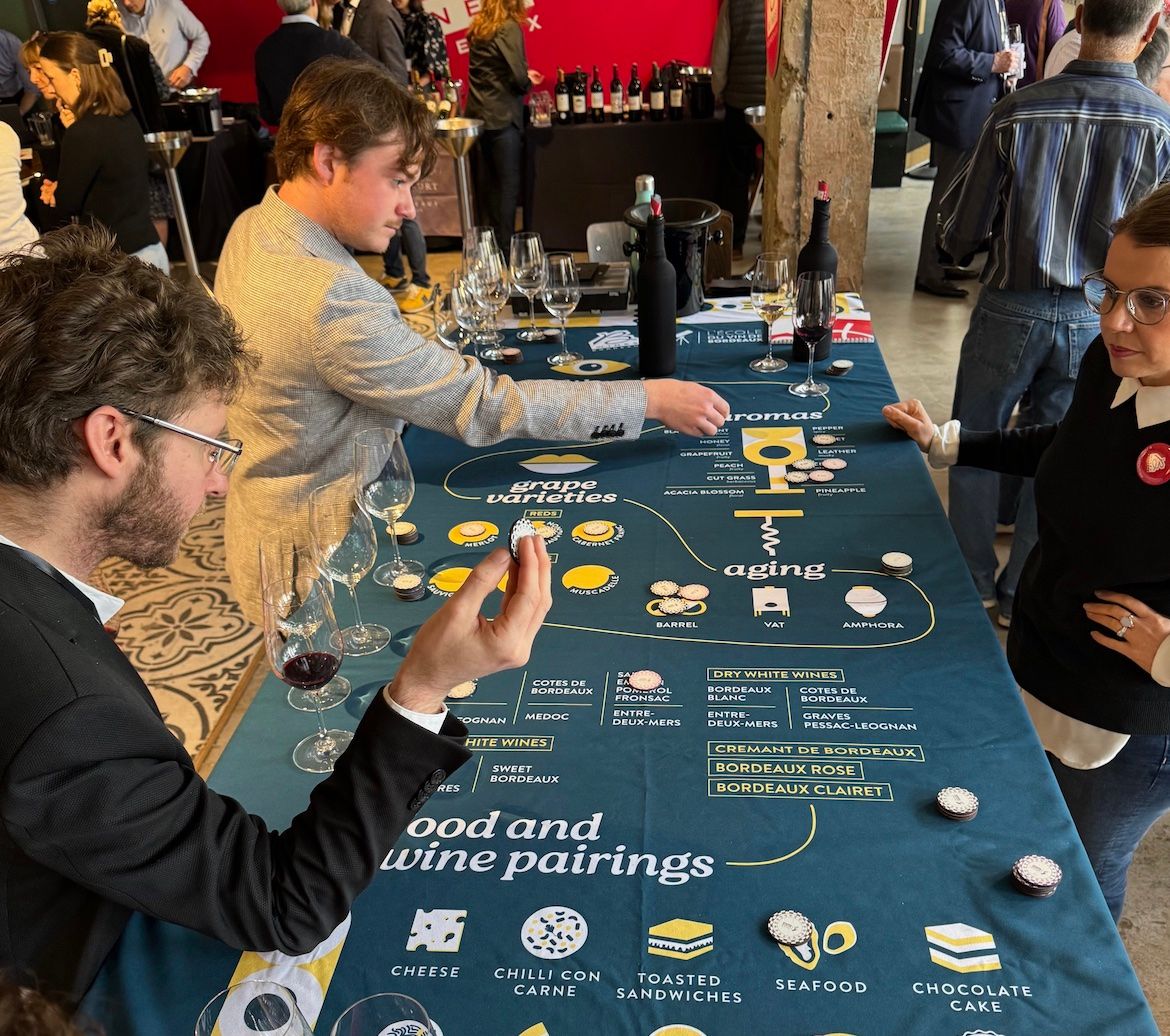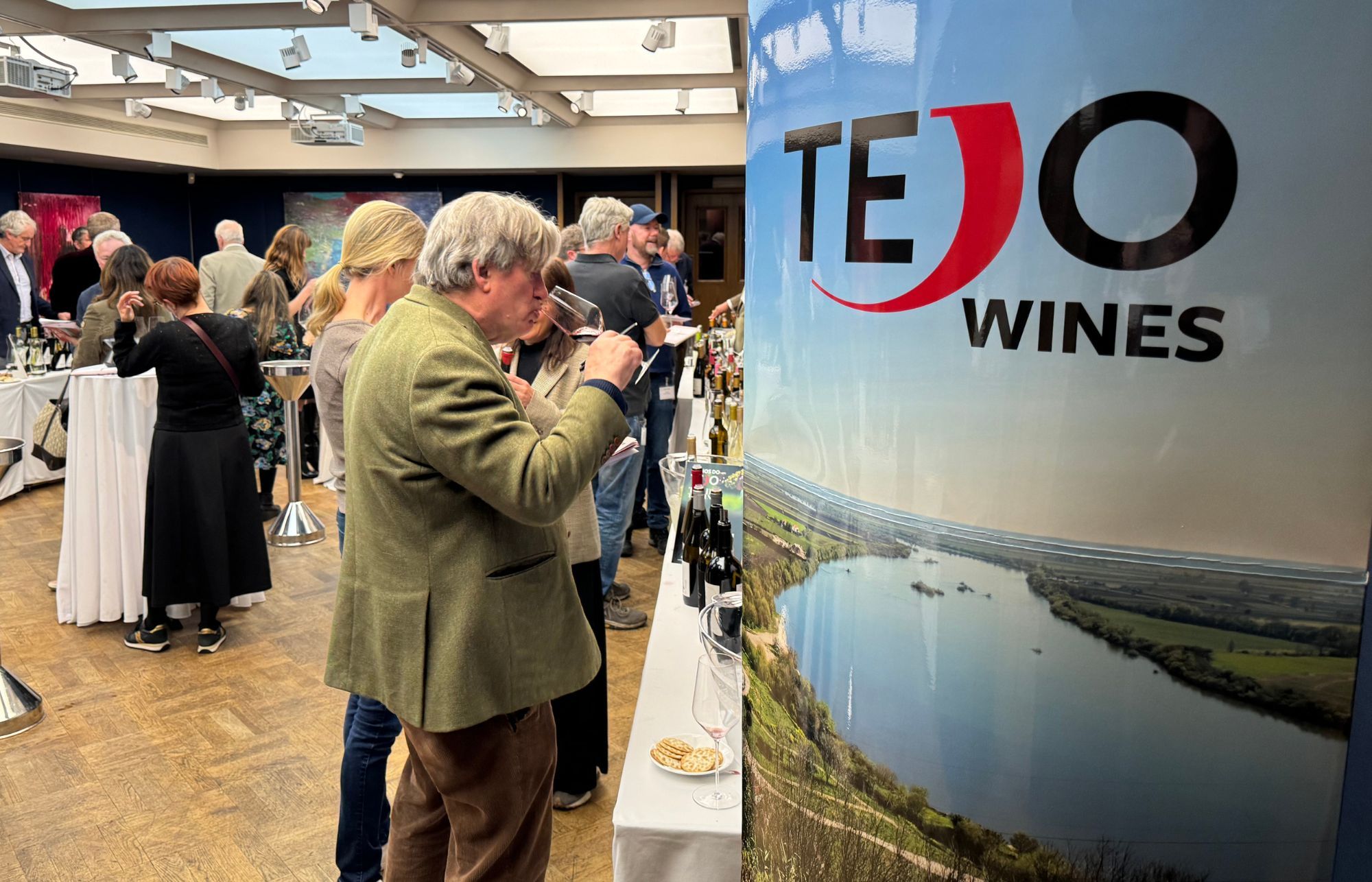“At last year’s massive New Zealand Wine tasting, Matthew Jukes’ top two ranked wines, out of the many hundreds on show, were both Valli Pinots,” writes Dean
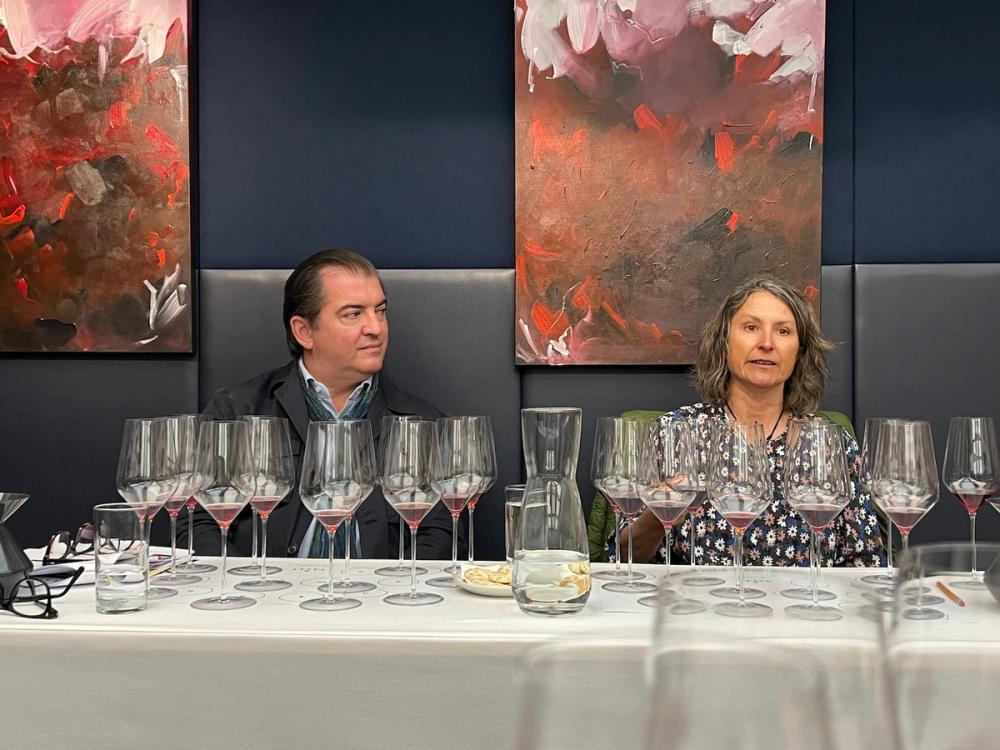
“The wines I worry about tend to get international recognition!” Valli winemaker Jen Parr and Matthew Jukes – Valli Wine Pinot masterclass, London, October 16, 2023
Matthew Jukes, who chaired the Valli Wine Pinot Noir Masterclass with winemaker Jen Parr, made an interesting point that the 12 Pinots on show “flipped the New World and Old World on their heads.” It wasn’t until that evening when I popped a bottle of 2019 Beaune 1er Cru (from a top producer) that I totally got what he meant – where the Valli Pinots at the tasting were elegant with a precise sense of place, the Burgundy didn’t feel like it came from Beaune at all – it was tasting darker, richer more concentrated with sweeter fruit…it felt more like a New World Pinot.
Contrast that to the wines of the tasting – three mini-verticals from three sub-regions of Central Otago – where we tasted precise, terroir-driven, expressive fine wines of incredible elegance and beauty. Their drive and structure would fox the most savvy of blind tasters.
Jukes praised the “sensitivity, accuracy, and the GPS of these Valli wines,” and contrasted it with the way Burgundy is changing: “In Burgundy the blurring is very evident, there’s a lot of blurring going on between the regions.”
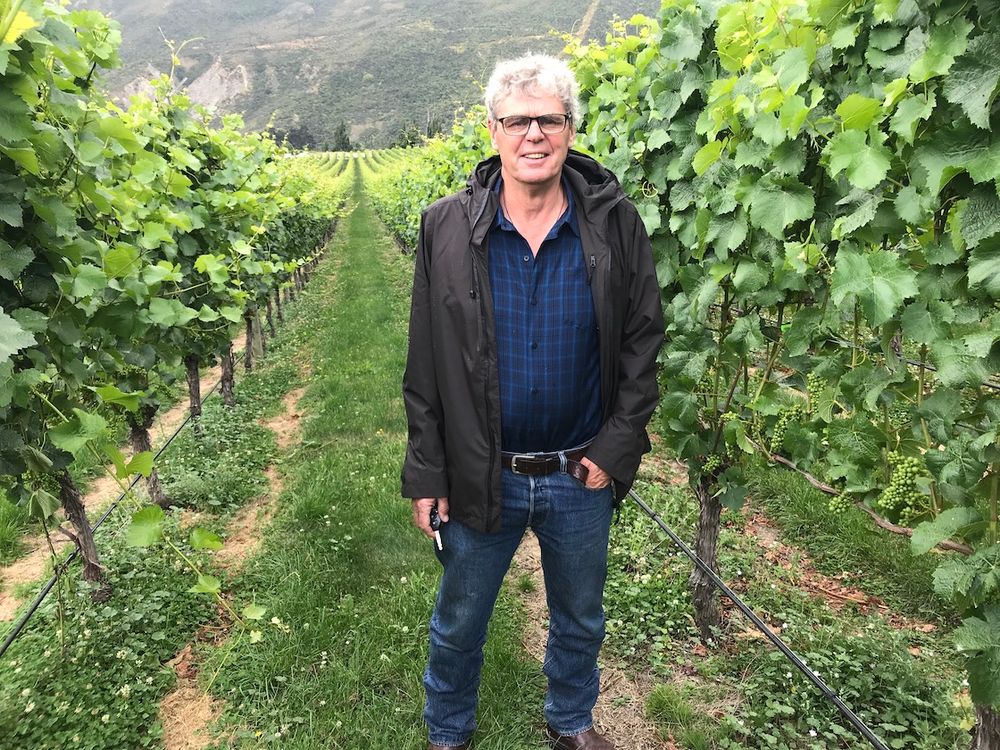
Central Otago pioneer Grant Taylor cut his teeth at Dujac before setting up Valli with a focus on sub-regional wines (photographed 2019)
Burgundy and Central Otago: close ties
To set the scene, Valli is the creation of pioneering winemaker Grant Taylor who has been making wine in Central Otago since 1993 when there were just 20 hectares planted, now there are over 2,000 hectares.
The comparisons with Burgundy and Valli Wines are plain, as we’ll see when we take a deep dive into the wines, particularly with those from Waitaki whose limestone-based soils have a natural affinity with Burgundy and lend the wines (made from Dijon and Pommard clones) an ethereal quality highlighted by perfume and minerality.
Beyond this, there has to date been a healthy respect between Central Otago and Burgundy. The New Zeala region is the only wine region in the world that has ever had an official work exchange programme with Burgundy. Although it is no longer formally still in place the Burgundy Central Otago Exchange featured such luminaries as DRC’s Aubert de Villaine who commented at the time “that to see people so far away carry the same philosophy and passion is so touching and something I really love.”
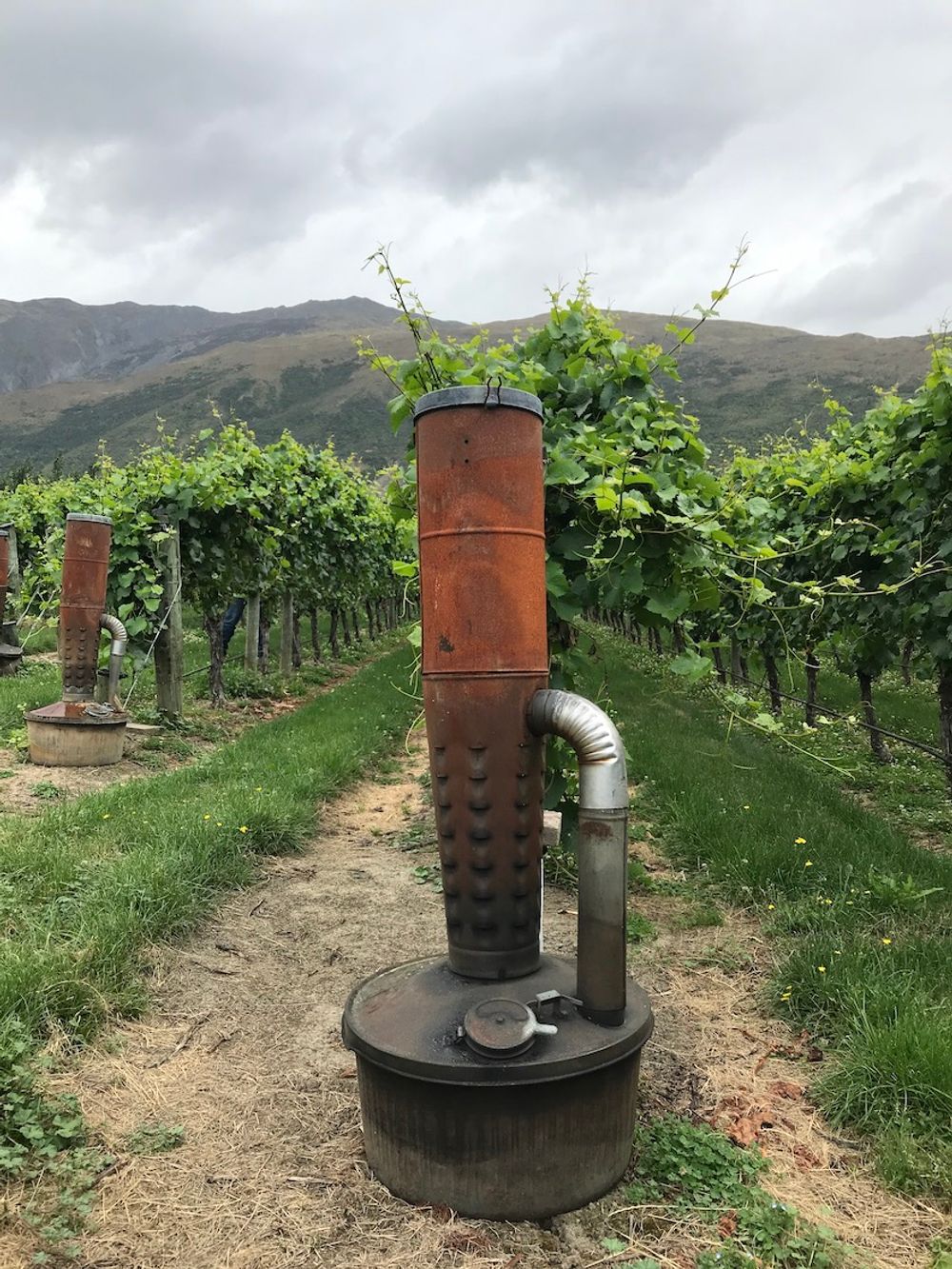
Frost prevention: like Patagonia, Central Otago is on the very limits of viticulture, Gibbstone Vineyard
Budding winemakers who swapped countries took away key learnings from each other. Assistant winemakers from Central Otago took away “grape variety, single site, open fermenters, pigéage, oak types, élevage and the shape of the bottle,” according to Nick Mills who is the owner of Otago’s Rippon Estate and co-founder of the Exchange programme. “For them it was a chance to experience the freedom and self-confidence of Central Otago. We have freedom and they have restraint.”
Distinct sub-regions
Planting with a blank canvas on virgin, agricultural land that has complex soils, is exactly what Grant Taylor did when he set up Valli in 1998, first at Gibbston, and now at three other sub-regions. Taylor learned much of his craft at Dujac and like his Kiwi peers, he was able to do this free from the sort of constraints that Burgundians have grown used to – in Central Otago there are not the detailed geographical and socio-political overlays to contend with. Taylor also had the foresight to focus on sub-regions and bring out the characteristics of each – the first wine producer to be doing this in Central Otago.

Jen Parr: the Otago sub-regions will get recognised in time much like Burgundy
So, given this focus on making wines with a sense of place, I was interested to know whether describing Valli wines as ‘Burgundian’ was a compliment or not to Parr?
“Of course, assuming it was intended as a compliment! I have worked in Oregon and California and admired it from other places, always as a Pinot Noir and as a wine of stature.”
But in time, Parr believes the sub-regions of Central Otago will become just as recognised. “In 20 years time people will say ‘that wine is from Bannockburn’, today if people say Central Otago that’s good but Bannockburn? Wow! In 20 years-time, though, it won’t be such a surprise.”
In time, she also believes that Valli’s style will also become more apparent, in much the same way that people come to recognise the style of a painter.
“The signature on a work of art is small but over time you recognise that ‘oh that’s a Monet’ even though the signature is tiny you see the signs. My goal is that over time you taste a Valli Wine and you will recognise it as such, even though the individual ‘signature’ is small.”
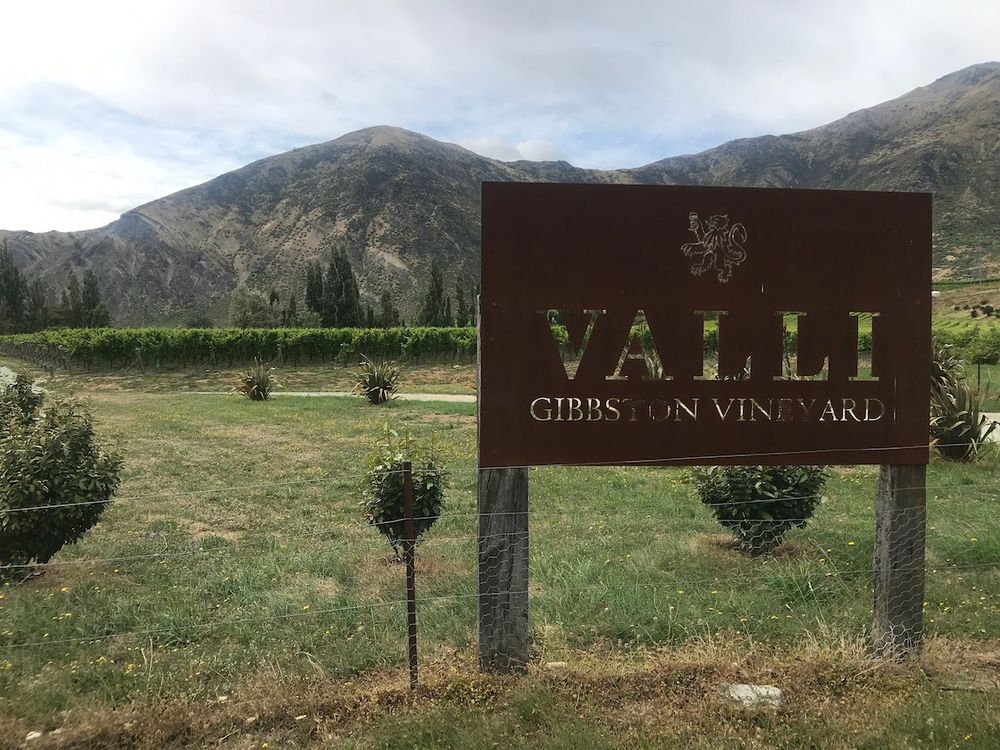
Gibbston was the first vineyard to be planted by Taylor
So how were the wines tasting?
Valli has vineyards in four sub-regions: Gibbston, Bannockburn, Bendigo and Waitaki. We tasted wines from three (Bendigo excluded) and the four most recent vintages – all of which were very different and showed off both site and climate.
Matthew Jukes, myself and anyone else tasting that day were simply floored by how good these wines were. They were old school Burgundy by any other name, at a fraction of the price.
Valli Gibbston Vineyard
The first of Valli’s vineyards to be planted, in 1999 and 2000. It has an altitude of 350m (around that of Bannockburn and Bendigo), is semi-continental in climate and has the most rainfall out of the four sub-regions with 600mm per annum – Central Otago is still by and large a desert. Pinot Noir and Pinot Gris are grown.
Gibbston Pinot Noir is characterised by a heightened perfume and silky fine tannins and is used by some producers to lift fruit in a blend – “the secret weapon in a Central Otago blend,” says Parr. She also confessed that the sole reason for her moving from Oregon to Valli was the fact that she wanted to make Pinot in Gibbston.
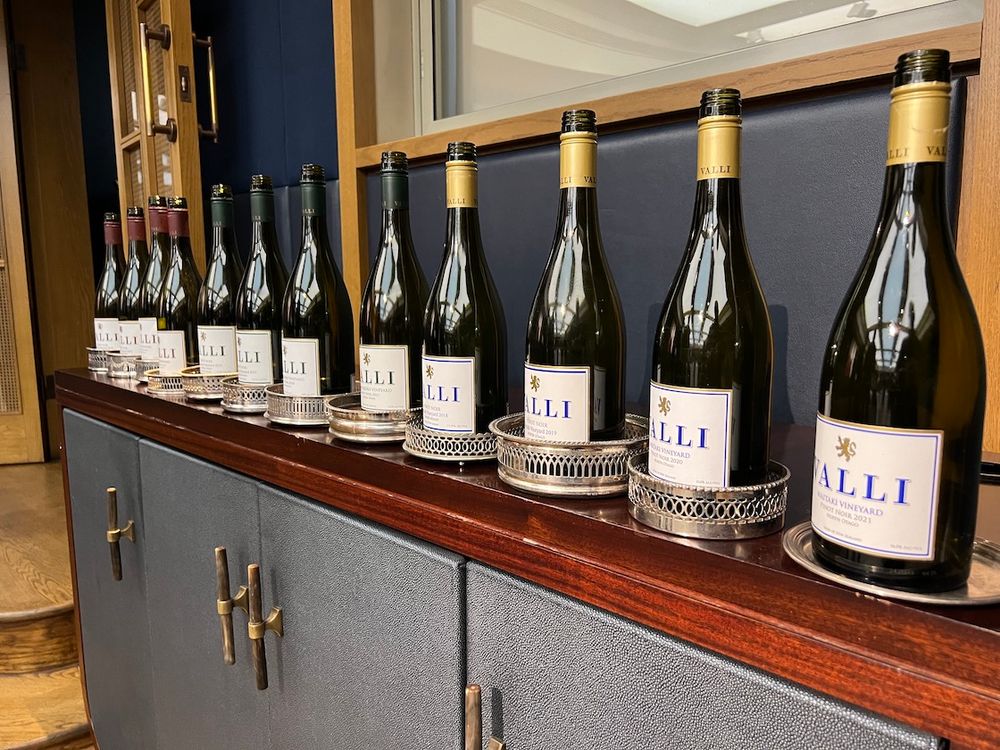
Valli Gibbston Pinot Noir 2018
From the hottest and wettest vintage ever – this is a beautifully balanced, perfumed Pinot – pale garnet, heady wafts of red fruit. In the mouth the wine is light, textured, great depth and layers of red fruit a touch of herb from the 30% sensitively-handled whole bunch. 30% new oak is elegantly cloaked by ripe fruit. Great poise, mouth-watering length, very classy indeed. This looks and feels more like a Chambolle-Musigny or a top Oregon Pinot rather than how you typically pigeonhole New World Pinot.
Parr explains: “Most people would be dismissive of Central Otago in 2018 – but at the time the wines were released – when you looked at an array of wines – great viticulture was the central commonality.” Valli was looking at picking in February but then rains came which “was a Godsend because it forced our hand not to pick earlier.”
Parr reckons that for those producers who cropped higher and whose intentions you could question “the rain forced them over the edge.” The warmest vintages favour the cooler sites, such as Gibbston.
Valli Gibbston Pinot Noir 2019
Winner of ‘Best New Zealand Red Wine’ at the Decanter World Wine Awards 2021. A true classic from a growing season where everything went right. Darker than the 2018, more russet-looking with a slightly shy nose that reveals in time red fruit berries, herbs and dried petals. A whiff of smoke maybe. On the palate there’s more flamboyance with more cassis, spice and exotic flavours. The mouthfeel is silky, clean, with bright acidity and an elegant, spiced finish. Some serious depth here.
Parr explains: “the wine was helped by the diurnal range, everything went right, it’s a magic wine. Winning a trophy for it is re-assuring because it shows that if you allow the wine to simply be, then people will go with you.”
Valli Gibbston Pinot Noir 2020
Younger, with more power in the engine, this is a stunning example of Gibbston Pinot from a cool vintage where Valli managed a full five-ton-per-hectare crop. Light garnet on the eye, more herbal on the nose with rosemary and pink peppercorns mingling with raspberry and red apple, an intensity here, an almost fruit syrup note; in the mouth there’s petals, fruits of the forest, fresh-pressed berries, a lovely poise and elegance. “Very Burgundian” I had in my notes.
Parr explains: You get a vintage like this “once in every 10 years”, 2007 being the one similar prior to 2020. Delicate, but not fragile is how she describes the wine. “Only people who chose to plant in Gibbston will always make Pinot Noir.” Other people who source fruit from the sub-region “may have other places for it to go.”
Valli Gibbston Pinot Noir 2021
From the smallest ever harvest comes a much friskier, earlier-drinking wine that still has a great deal of beauty. Garnet-red to look at, it has more youthful fruit – cherry, plum with graphite. Fresher in the mouth than the 2020, bright, more pronounced acidity with fine-grained tannins (emery board-like says Jukes), you notice the wood more, slightly scratchy, less fleshy fruit, cedar with dark red fruit and dried flower petals.
Parr explains: “I taste this wine with real anxiety – it was a really tricky vintage – and it brings back heart palpitations.” Frost and disease reduced production by 60% (which returned to full glory in 2022). “We’re paid to grow it so we need to make something out of it,” is how Grant Taylor addressed the fruit. Parr elaborated saying that her winemaking approach is “Responsive not reactive… you see what rattles and then decide what to do… but never say always and never say never.”

“I love the smell of Pinot in the morning… it smells like victory!” (with apologies to Robert Duval/ Francis Ford Coppola)
Bannockburn Vineyard
Planted in 2000 at around the same altitude as Gibbston, with a similar semi-continental climate but slightly cooler and with less rain (450mm per annum). Wines from here tend to be more structured.
Valli Bannockburn Pinot Noir 2018
From a warm vintage, this took a while to open out in the glass. Russet to look at, the wine was fresh and open, with intense plum and cherry aromas leading into more fleshy black fruit notes. In the mouth the wine was sleek with fully integrated, silky tannins, ripe fruit with a lack of definition perhaps – clean, refreshing with a distinct cardamon note. Gastronomic.
Valli Bannockburn Pinot Noir 2019
Standout wine in the Bannockburn flight – dense, tense and flavour-packed. Bright garnet to look at, the aromas are more intense both savoury and floral. In the mouth the wine is fresh, fleshy, with beautiful balance and layers. Fabulous length, the vibrant acidity carrying the layered, complex fruit well into a taut finish. My notes said “Wow!”
Parr explains: “This is a frost-free vineyard but we had frost in 2019 and we also had hail and a cyclone which knocked over a third of the vines. We did get a full harvest however – the stress that nature delivered you find in the intensity in the wine.” Like the Gibbston fruit, Parr is only using 20% whole bunch in this wine.
Valli Bannockburn Pinot Noir 2020
Winner of Best in Show at the Decanter World Wine Awards 2022. The wine is deep garnet, the nose more open with greater concentration of red and blue fruit. Fresh in the mouth, more breadth in the mid-palate, greater structure and texture. Spicier with a big finish. Matthew Jukes said of this wine: “this wine has greater amplitude, it gets angry, it draws you in and then scares you away…. tells you the rules nice and early.”
Parr explains: “Like my 2019 Gibbston if I used one word to sum it up it would be ‘perfume’ – with Bannockburn it is ‘silky’. Felton Road’s style is riper and richer but it always has a silky texture. Regarding the Decanter Best of Show award – the wines I worry about tend to get international recognition!”
Valli Bannockburn Pinot Noir 2021
With 30% whole bunch this is a wine that ticks all the boxes for Pinot nerds. Bright garnet with amplified spice and perfume – an attractive array of secondary notes such as wild herbs, leather and flint. Much more power in the mouth, fresh, richer fruits with good grip and persistent finish. Touch of cream in youth. Jukes adds “This is for the Pinot Noir freaks – it’s not textbook, it breaks away from the norm – the oak hasn’t particularly marked it, it is fruit-driven. Ooh this is real wine, action-packed, it’s tweaking all of my Pinot excitement buttons.”
Parr explains: “Everyone can see into the heart of this wine. It was a cooler-leaning harvest and has that silkiness. It’s a wine for contemplation (it’s always about pleasure) but perhaps too contemplative for some.” Interestingly, she said that one of the challenges she has as a winemaker these days is having a balance between making a wine for those who take a bottle home to drink immediately and for those who still cellar wine.
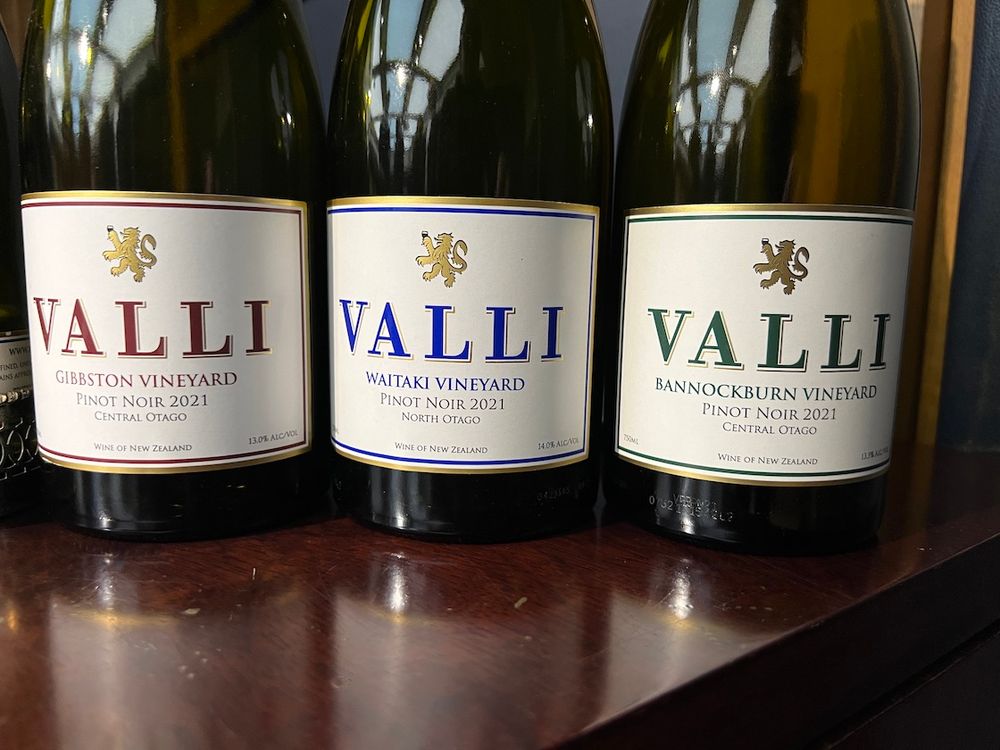
The three new Pinot Noir releases
Valli Waitaki
“If making wine from Central Otago is for the insane then making wine in the Waitaki is for the clinically insane,” says Jen Parr who adds that when people first see the fruit they ask “How do they make wine out of this?”
Welcome to Waitaki in North Otago… which is New Zealand’s newest and most exciting wine region, one that has an affinity with Burgundy through its limestone-based soils. Just 30 minutes-drive from the coast, this is a maritime affected climate. But it’s not for the feint-hearted, it is hard to grow grapes here commercially. Parr explains that when the Waitaki fruit arrives at the winery people scratch their heads as to how you make wine from the bunches “the de-stemmer really spits the dummy out with this fruit, it takes five times as long than other vineyards.”
Valli’s vines were planted in 2001 with the first commercial crop released in 2004. In 2005 they made no wine and in 2007 just one barrel. The financial crisis of 2008 saw a lot of those planting in the early 2000s going out of business leaving just five serious producers here which have some history and are keeping the region on the map.
Make no mistake, though, these wines, coming from early ripening Dijon and Pommard clones are seriously good with a truly ethereal quality coming from the limestone soils. Apart from the Pinot Noir, Valli makes an orange wine from Pinot Gris here plus a Chardonnay that is phenomenal and impossible to source. Just saying.
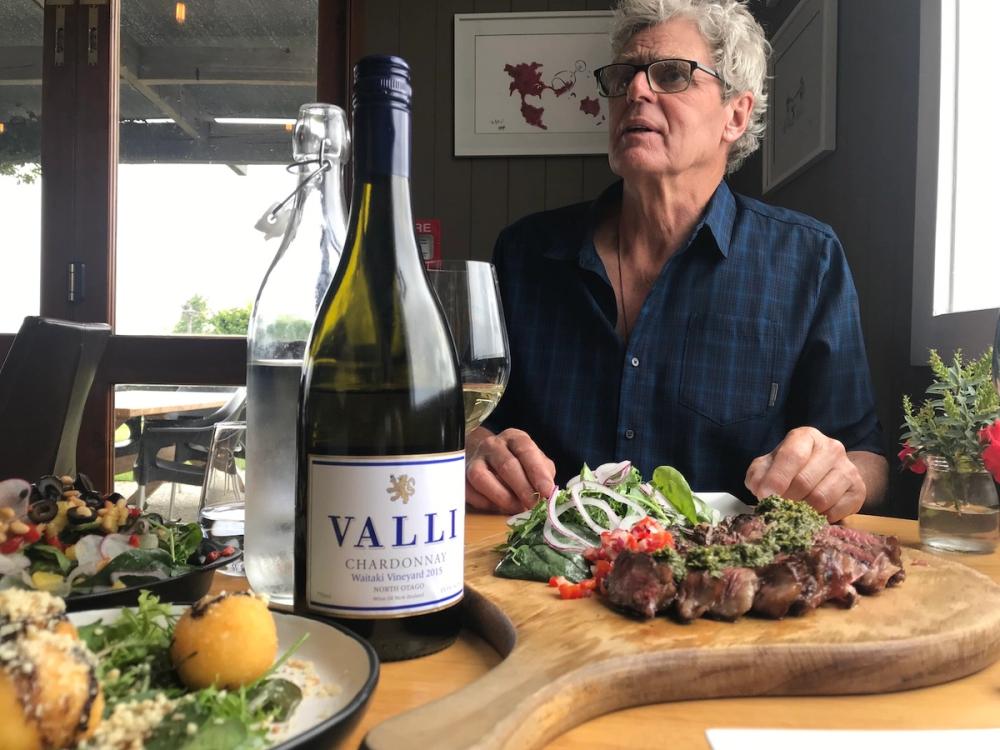
If you ever see this wine buy it – no dithering. Lunch with Taylor, 2019.
Valli Waitaki Pinot Noir 2018
Instantly recognisable – these wines are so fresh, bright, clean, structured and made with such purity. Garnet; aromas waft out elegantly of the glass and include wild red berries, flowers, wild herbs and cedar. On the palate the wine has elegance, poise, beautiful fine-grained texture – married with acidity – that gives it an energy and devastating finish.
Jukes remarked that “these Pinots are shaped more like Nebiolo, they are linear, graceful with real power under the bonnet – the acidity is electrifying and give the wine such dynamism.”
Parr explains: “Waitaki is the most seasonally influenced – which is the common thread of the place. 2018 was a warm year, when the Waitaki grapes arrived we were so busy we assumed they were Central Otago fruit. It’s the only time we were getting 100gm bunches.”
Valli Waitaki Pinot Noir 2019
Parr only had .75 tonnes of fruit to play with in this vintage – she describes it as “trying to make wine from cassis.” The power in the wine is monumental – a real walk on the wild side with intense fragrance, savoury undertones and wild energy. This wine is off-the-scale good. On the nose the wine has a range of nuances not witnessed in the other vintages – spices, herbs, olive, maple – on the palate too there is ripe, juicy fruit but other secondary characteristics – earth, saline. Beautiful, silky tannins with an underlying grip, more tense with a playfully tart finish.
Parr explains: “Wine isn’t a living thing per se, wine has an energy and with Central Otago wines that energy is terrestrial.” She adds that what she is trying to find is a levity in the wine or “the crack that lets the light get in, to quote Leonard Cohen.”
Valli Waitaki Pinot Noir 2020
Classic complex Waitaki Pinot which has a ripe, intense nose with layers of fruit, savoury nuances, a hint of wild strawberry syrup. A lovely fresh palate, more fine textured, juicy but with the purity shining through. Intense, energetic just stunning.
Valli Waitaki Pinot Noir 2021
Clearly younger and not fully finding its feet yet. Garnet; more reserved on the nose but still with some complexity – wild strawberry, mulberry, mixed with herbal and savoury undertones. The palate I found quite rounded (no whole bunch was used in this vintage), saline and a dusting of chalk on the finish.
My least favourite Waitaki in the line-up but I still ended up buying a case which says it all – do not under-estimate these wines they are sensational. The next day (after the Beaune) I opened up a 2016 Waitaki for dinner and simply purred.
My favourites from the tasting, incidentally, were: Valli Gibbston Pinot Noir 2020, Valli Bannockburn Pinot Noir 2019 and Valli Waitaki Pinot Noir 2019.
And in conclusion….
Matthew Jukes mentioned more than once the recognition that Valli commands outside of New Zealand: how an Australian critic recently told him that Valli was the best New Zealand producer bar none; and at last year’s massive New Zealand Wine tasting, Jukes’ top two ranked wines out of the many hundreds on show were both Valli Pinots.
“Well done for making at along this early morning,” Jukes rounded up, “and if you got an invite and didn’t make it you’re a fool!”
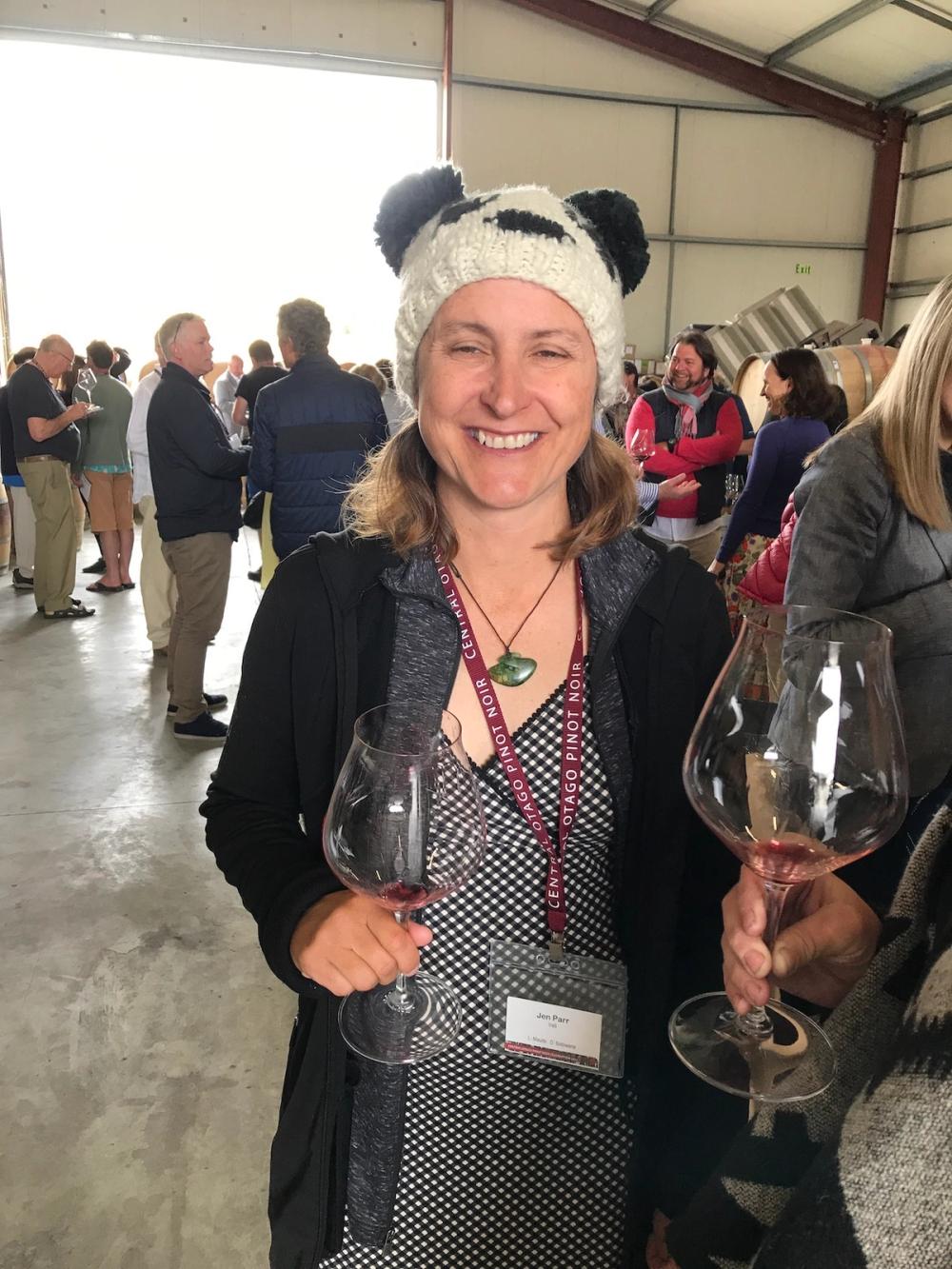
Jen Parr, Central Otago Pinot Festival, January 2019 (sorry Jen! I knew I was going to use this pic. one day!)
The Valli Wine Pinot Noirs are sold and distributed in the UK through New Generation Wines, which is a commercial partner of The Buyer. To discover more about them click here.
The New Zealand New Release Wine Tasting takes place in London on November 14 at St James Room, 67 Pall Mall, London, SW1Y 5ES between 10am-4pm. For further details and to register contact Sarah Shepherd on sarahs@nzwine.com.


